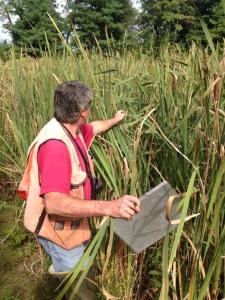 For those of you who don’t know, UConn’s Hillside Environmental Education Park (HEEP) is actually a remediated landfill. In an effort to diminish the chemical pollution of the landfill, the university implemented Wetland Mitigation and Closure Plans, and later constructed the HEEP to be used for research, education, and recreational p
For those of you who don’t know, UConn’s Hillside Environmental Education Park (HEEP) is actually a remediated landfill. In an effort to diminish the chemical pollution of the landfill, the university implemented Wetland Mitigation and Closure Plans, and later constructed the HEEP to be used for research, education, and recreational p urposes. Continued monitoring of the wetlands is essential to protecting the vegetation and wildlife of the park. Today, Chris Mason, UConn’s wetland scientist and contractor of the HEEP project, led an invasive species removal effort in the park. Phragmites and Japanese Stiltgrass have been spreading and expanding throughout the HEEP, likely due to the dry weather and dispersal by deer and other animals, and are known to crowd out native species. The plan was to eliminate visible invasive through the application of herbicide, and to monitor the distribution and trends of these invasive species in order to protect the existing ecosystem.
urposes. Continued monitoring of the wetlands is essential to protecting the vegetation and wildlife of the park. Today, Chris Mason, UConn’s wetland scientist and contractor of the HEEP project, led an invasive species removal effort in the park. Phragmites and Japanese Stiltgrass have been spreading and expanding throughout the HEEP, likely due to the dry weather and dispersal by deer and other animals, and are known to crowd out native species. The plan was to eliminate visible invasive through the application of herbicide, and to monitor the distribution and trends of these invasive species in order to protect the existing ecosystem.